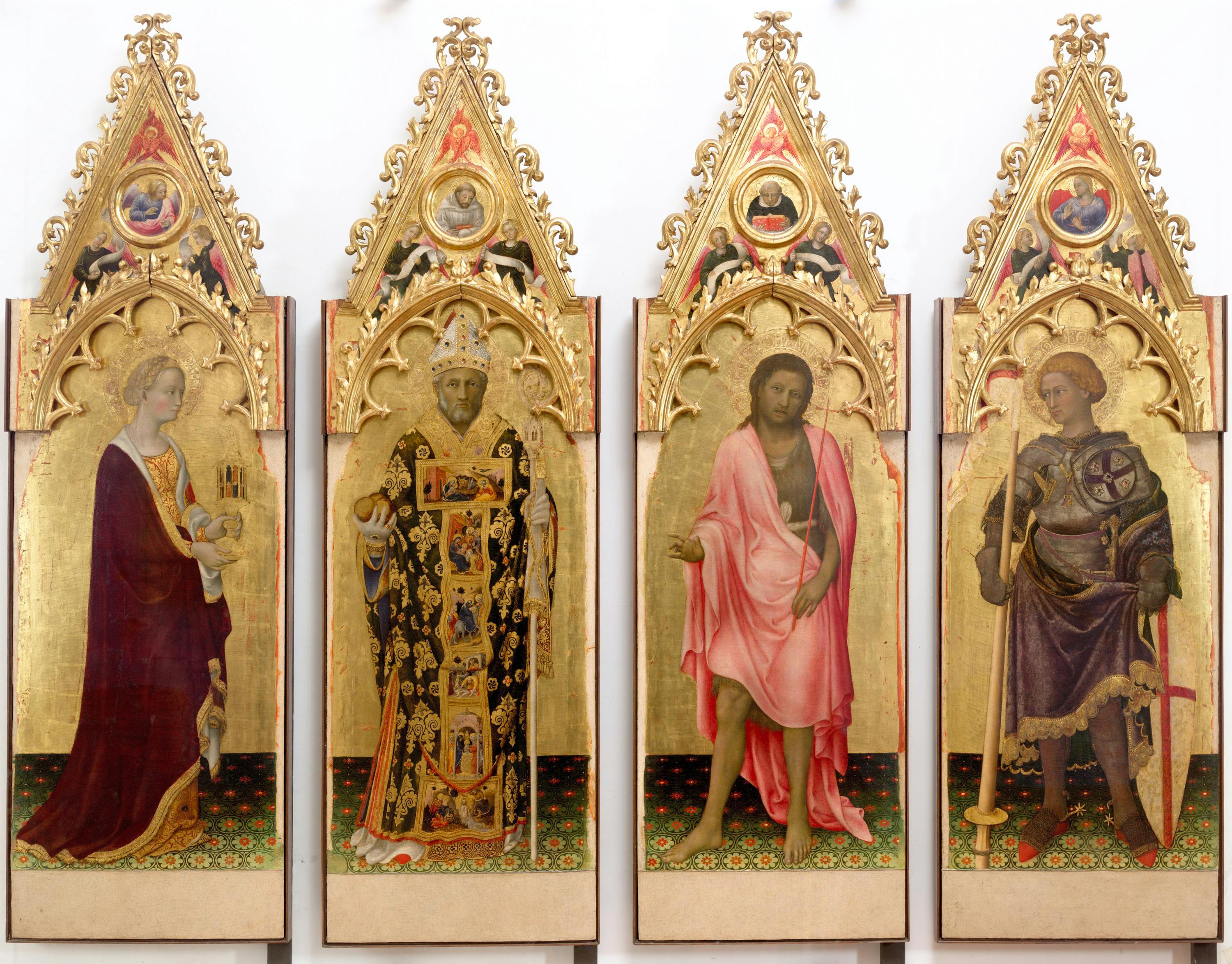Saints Mary Magdalene, Nicholas, John the Baptist and George In the peaks: the Announcing Angel, Saint Bernard of Clairvaux and Saint Dominic; the Virgin Annunciate
Gentile da Fabriano (Fabriano ca. 1370 - Rome 1427)
The four panels, surmounted by peaks decorated with pairs of angels and figured medallions, were part of a polyptych where in the center was depicted the Madonna and Child Enthroned with Angels (now in the National Gallery in London, inv. L37). The piece should have appeared as a grandiose altar work, equipped with sumptuous carved, gilded, and painted wooden carpentry, and completed at the bottom by the step in which episodes from the legend of St. Nicholas were illustrated, which today are divided between the Vatican Pinacoteca (inv. 40247-40250) and the National Gallery of Art in Washington (inv.1939.1.268).
The iconographic attributes of the four saints allow their identification. Mary Magdalene, the redeemed sinner, is wearing a red dress and holding a jar with the perfumed ointment with which she paid homage to Jesus. Saint bishop Nicholas is portrayed next to her; originally he was placed in a position of honour to the right of the Madonna and Child. In addition to the bishop's vestments and the pastoral staff typical of the ecclesiastical office, the saint carries three golden balls in his right hand, which refer to one of the most famous miracles of his legend. The next figure is that of John the Baptist, patron saint of the city of Florence, characterized by the ascetic's unkempt appearance and the rough fur robe worn under his red cloak. Lastly, the sequence is closed by the noble knight and martyr George, who wears a shiny armour and carries a banner and shield bearing a red cross on a white field, which refers to the cross of Christ and the Church.
The sumptuous polyptych surmounted the high altar of the church of San Niccolò Oltrarno in Florence and was commissioned as a testamentary bequest by a wealthy merchant, Bernardo di Castello Quaratesi, who died in 1423 and held the patronage of the altar since 1421. An inscription in the frame, which has been lost and handed down from ancient sources, bore the name of the painter Gentile da Fabriano and the date May 1425.
Together with the Adoration of the Magi (Uffizi, inv. 1890 no. 8364), this work represents the peak of Gentile da Fabriano's activity in Florence, where he arrived in 1420 after experiencing the splendor of the courts of central and northern Italy. Six centuries later, it is still possible to admire the technical expertise achieved by the Marche's painter in working with gold and silver leaf, with effects of ostentatious preciousness and translucent surface. The large number of decorations and superabundance of drapery, that were typical of the international Gothic style, are accompanied by spatial references emphasized by the light degradation on the floor tapestry and by the foreshortened pose of the figure of Mary Magdalene, reflecting the Renaissance innovations in vogue in Florence.
After remaining in the church of San Niccolò Oltrarno, the polyptych was dismembered in the early decades of the 19th century, and in 1878 the four panels with the saints were donated to the Florentine Galleries by Niccolò Quaratesi.
It has been preserved at the Uffizi since 1879.
A. De Marchi, Gentile da Fabriano. Un viaggio nella pittura italiana alla fine del gotico, Milano 1992, pp. 176-184; A. Cecchi, I Quaratesi di San Niccolò Oltrarno e Gentile da Fabriano, in Gentile da Fabriano agli Uffizi, a cura di A. Cecchi, Cinisello Balsamo (MI) 2005, pp. 59-65; A. Cecchi, in Gentile da Fabriano e l’altro Rinascimento, catalogo della mostra a cura di L. Laureati e F. Mochi Onori, Fabriano 2006, pp. 256-261 cat. IV.3
